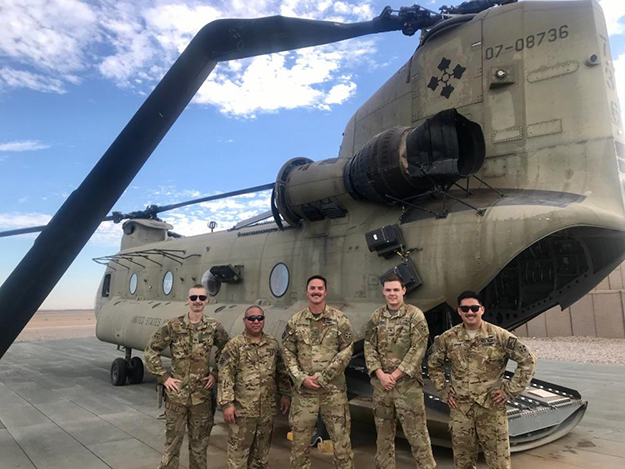On the night of Nov. 20, 2020, high above the southern desert of Afghanistan, Chief Warrant Officer 3 Ryan Schwend and his CH-47 Chinook helicopter crew members found themselves in a situation that no aviator ever expects to be in.
Schwend along with Chief Warrant Officer 2 Eugene Park, Staff Sgt. Ben Kamalii, Sgt. Andrew Donley-Russell and Sgt. Ty Higgins, all members of Bravo Company, 1st Battalion, 168th General Support Aviation, were on a routine mission that they've done many times before.
With the draw down in Afghanistan in motion, bases were being consolidated and living spaces needed to be moved to accommodate the increase in troop movements. Their mission was to sling load relocatable buildings (RLB) beneath the aircraft from Kandahar to contingency location Dwyer - the site of the consolidated base in southern Afghanistan.
It was a dark nighttime flight with night vision goggles and low illumination. The flight of two CH-47s had already delivered two RLBs to CL Dwyer and were on their second turn to deliver the second pair of housing units. They had been flying almost seven hours that night.
"We had just started our approach - we were flying over the Helmand Valley at about a thousand feet," recalled Schwend. "When a loud thunderous bang was heard in the aircraft - louder than anything I have ever heard in a Chinook."
The aircraft immediately jolted into a right bank.
"It felt and sounded like I got hit in the head with a hammer," crew chief Donley-Russell said.
Higgins screamed into the internal communications system, "Jettison, jettison, jettison!" as he released the load.
Co-pilot CW2 Park promptly stabilized the aircraft by taking control after the violent impact they felt. A quick glance at the instruments told him the aircraft was now under immense strain. The controls were soft and mushy - much like driving an old car without power steering.
Schwend and Park were able to maintain control as they approached the perimeter of CL Dwyer. Schwend took the flight controls and radioed to the lead Chinook to get out of their way as they needed as much space as possible to troubleshoot the problem.
Park radioed to the tower to declare an emergency and asked that a ground response team immediately dispatch to help with their situation.
The crew in the back immediately began to run through the cargo hook release emergency checklist as they tried to find out what happened. They saw that the load did not completely jettison and was pinned to the bottom of the aircraft in a mangled mess. It was determined that they could not fully land the aircraft over fears that it could rollover causing further damage or possible fatalities.
According to the final report of the incident, the side wall of the RLB on the sling load collapsed which "allowed air to enter into and push the load horizontally to the left and upward making impact with the aircraft." What the crew didn't know at the time was that as the load made impact with the aircraft, it also made contact with the rear rotor system causing unseen damage to the blades. However, they were still able to keep the aircraft flying.
As Schwend struggled to maintain a steady hover, the response team was beneath the aircraft trying to dislodge the mangled wreckage. After several attempts they successfully cut the load from beneath the fuselage and the crew moved to land and shut down their helicopter.
During the shutdown procedure and as the rotors were slowing down, Higgins noticed that the blades were beginning to sag. Earlier, during the impact from the load swinging upward, the blades sustained severe catastrophic damage. They were being held straight out by the centrifugal force. As the blades slowed down after shutdown they began to sag before finally impacting the air frame causing further damage and finally coming to an abrupt halt.
For their calm and collective actions, the entire crew were awarded the U.S. Army Aviation Broken Wing Award in a ceremony held at the Army Aviation Support Facility #1 at JBLM, June 18, 2022. This is an especially rare honor as historically the award is usually given just to the pilots.
The Broken Wing Award was established in 1968 and is rarely bestowed. According to the U.S. Army's criteria for the award "an aircrew member must, through outstanding airmanship, minimize or prevent aircraft damage or injury to personnel during an emergency situation."
For their actions in the air leading to a safe landing and minimizing damage to the aircraft and saving each other's lives, all five crew members were awarded the Army Commendation Medal. And for their heroic and selfless actions on the ground below the damaged Chinook helping to dislodge the mangled load, four members from the Washington, Oregon and Utah Army National Guard were awarded the Army Achievement Medal.
Col. Scott Meyers was the commander of Task Force Ivy Eagles and was the senior aviator in Afghanistan at the time. His comments summed up their actions precisely.
"This particular aircrew, including CW3 Schwend, is to be commended for their actions," Meyers said. "Which had they not completed deliberately and calmly, could have led to a greater loss of equipment and quite possibly loss of life."




Read Comments